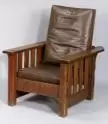Who Made Arts & Crafts Furniture the Longest Time?

While all five started making Arts & Crafts furniture in the early 1900s, one by one they each dropped out, ending with Leopold who in 1922 shut down his Arts & Crafts line in favor of colonial reproductions, and Albert who switched over to English Tudor about the same time.
In their place stepped up the J. M. Young Company of Camden, N.Y., who had been making Arts & Crafts furniture since 1904 (or before) and who continued to produce high quality, respectable Arts & Crafts furniture until the 1950s.
Founded in 1888, this family company produced a wide variety of Victorian furniture until, like the Stickleys, they began to concentrate on Arts & Crafts. Unlike the Stickley men, however, John Young and his sons were content to manage a workforce of only 12-14 workers. Because their output was small, they were able to maintain a high degree of quality. Proud to use modern equipment, such as a tenon cutting machine, the Youngs always turned to hand-craftsmanship for the fitting and finishing of their furniture. All of the drying, cutting, fuming and finishing of their furniture was done in their Camden workshops.
The Youngs were well aware of the designs of Gustav Stickley, for their earliest and most popular Morris chair (pictured) was clearly modeled after Stickley’s flat-arm model #332 recliner. The same can be said of their affinity for several L. & J.G. Stickley designs which they modified slightly and sold under their own paper label.
Extensive research conducted by authors Michael Clark and Jill Thomas-Clark indicates that the Young family had a close, positive and friendly working relationship with Leopold Stickley. When Leopold discontinued his Arts & Crafts line, he provided George and Clarence Young with finish formulas, specialized machinery and even customers for their Arts & Crafts furniture. Subsequent correspondence indicates that Leopold Stickley encouraged the Youngs to fill the void he had left in the Arts & Crafts market. Their furniture remained so popular it was shipped as far away as the American Embassy in Berlin and rubber plantations in Liberia.
Today, collectors have learned that the furniture of J.M. Young offers an affordable alternative to that of Gustav Stickley and L. & J.G. Stickley without making a sacrifice in either design or quality of craftsmanship. As the Clarks noted, “This small family business has left a significant legacy in the decorative arts by extending the life of the Arts and Crafts movement well beyond its once presumed death in the 1920s.”
For more information, see “J.M. Young Arts and Crafts Furniture” by Michael E. Clark and Jill Thomas-Clark (Dover Books).
– Bruce Johnson

